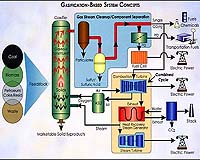Science and Technology Are Making Fools of "Food vs Fuels" Debaters
The researchers in Germany have devised what they say is a more effective method of breaking down the cellulose found in plants into sugar molecules, which can then be used to produce ethanol. The method uses an ionic liquid to first break down cellulose into shorter glucose chains, and then a solid acid resin to split those shorter chains into individual sugar molecules that can then be used for biofuels. The new approach could make for plentiful biofuels that don't compete with food crops.Item 2: Genomatica, a southern California company, has devised a clever way of reprogramming micro-organisms to produce valuable chemicals and/or fuels as feedstock for the chemical and energy refinery industries. The advanced biocomputational techniques developed by the company should accelerate the development of biomass to fuels/chemicals and CO2 to fuels/chemicals processes.
Even very-tough microcrystalline cellulose can be broken down into sugar molecules by using this approach, said lead researcher Ferdi Schüth of the Max Planck Institute in Mülheim. _Bioenergy
Genomatica’s core computational technology enables it to create a computerized model that simulates the myriad metabolic processes of a cell. It also enables Schilling’s team to determine the best series of metabolic processes—or pathway—for directing the cell to produce a particular compound....Genomatica's initial focus, understandably, is the high-value petrochemical substitution market. But using the same biocomputational methods to reprogram microbes to produce a wide range of fuels is just as possible, and 100% probably once Genomatica's cash flow from its microbial chemicals production stabilises.
...researchers under Mark Burk, Genomatica’s chief technology officer, succeeded earlier this year in manipulating a standard strain of E. coli to produce 1,4-butanediol, or BDO. The colorless, viscous liquid, used to make spandex clothing, skateboard wheels, car bumpers, dashboards and other resilient plastic materials, is normally toxic to E coli. But Genomatica’s engineered bugs were designed to churn the stuff out.
CEO Gann says the global petrochemical industry currently makes about 3 billion pounds of BDO a year for an estimated worldwide market of almost $3 trillion....
...The established “brute force” method puts crude oil under tremendous heat and pressure in refinery “cracking” units. In contrast, Genomatica’s bioengineered organisms produce BDO by consuming sugar, oxygen, and other nutrients in fermentation tanks that operate at temperatures that are lower than a hot tub. “We don’t need subsidies, by the way,” Gann notes dryly. The approach will be comptetitive even if the price of crude oil drops to $50 a barrel, Gann says. _Bioenergy
The UN, the EU, and Pelosi and Boxer can debate food vs fuels all they want. Such a vacuous level of discourse suits them perfectly. For those who actually want to solve problems--generally persons who stay far away from politics--the promise of real world rewards and achievements beckons.
Labels: cellulosic fuels, microbial energy




